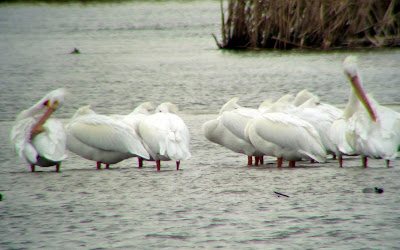 |
| Oops, a white-crowned sparrow, NOT a white-throated sparrow |
For just a few days at this time of year, we can hear the "Old Sam Pea-ba-deee, Pea-ba-deee, Pea-ba-deee" (usually written as "Peabody" but for those unfamiliar with the song I wanted to give a truer feel for the rhythm) song of the white-throated sparrow. Some people interpret it as "Oh sweet Canada, Canada, Canada." These sparrows are on their way through to their summer breeding grounds, which span most of Canada but do also include northeastern Minnesota. Dave says he looks forward to the arrival of the white-throats each year more than any other bird except perhaps the bobolink.
This afternoon we heard the sweet call (the link is to a YouTube video), and soon saw about eight of the relatively large sparrows in our front yard. The head stripes can be either white (above -- correction, this photo is actually a white-crowned sparrow; see addendum at top of this post) or a light tan color (below).We had some of both morphs in our group today. In the photo below, although it's not in good focus, you may be able to see another distinctive mark of the white-throats, the yellow spots in the area between the beak and eyes, known as the lores.
We had to go to Minneapolis this morning and on our way back we stopped at the All Seasons Wild Bird Store in Bloomington. Because of the arrival of the white-throats after we got home, we were immediately glad we'd bought a supply of millet seed, the little round seeds that are welcomed by some of the ground-feeding birds in particular. Dave scattered some on the ground and soon had not only the white-throats but a couple of chipping sparrows and a pair of mourning doves enjoying the new treat. Normally our ground-feeders have to rely on spillage from our black oil sunflower feeders, but we'll try to cater a bit more to a wider variety of birds this year. Other purchases today included some golden safflower seed (enjoyed by a variety of songbirds but not by squirrels, grackles, or starlings), a garland-style whole-peanut feeder (whole peanuts in the shell are said to be much liked by the blue jay, one bird that though we hear them nearby we didn't see once at our feeders this whole winter) and a holes-in-a-log suet feeder.











